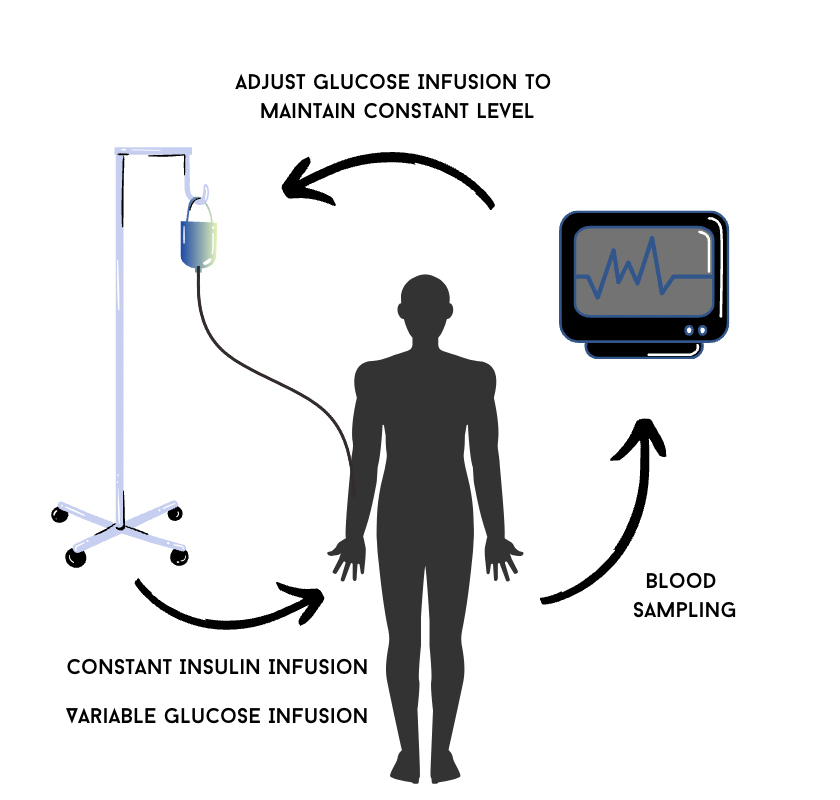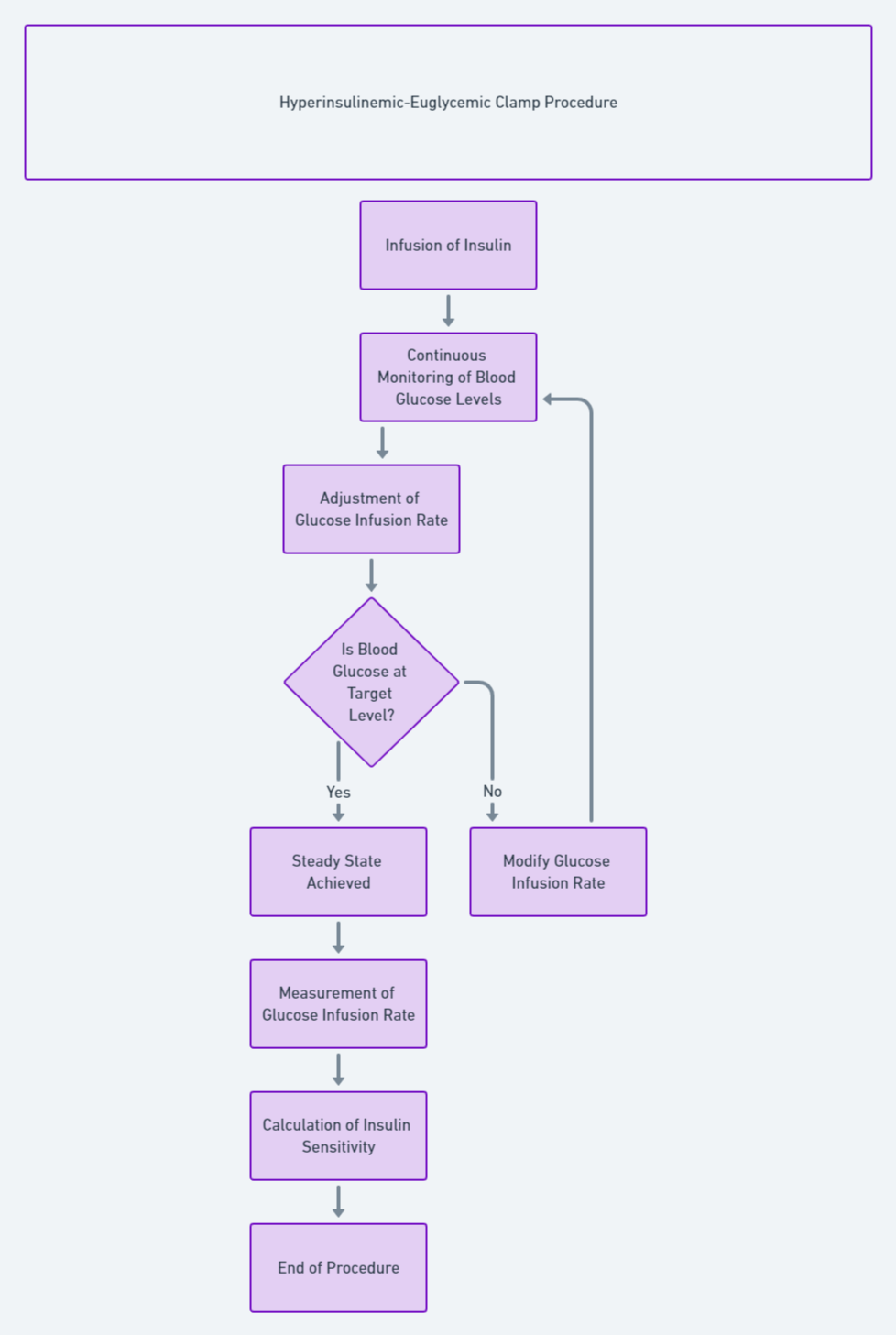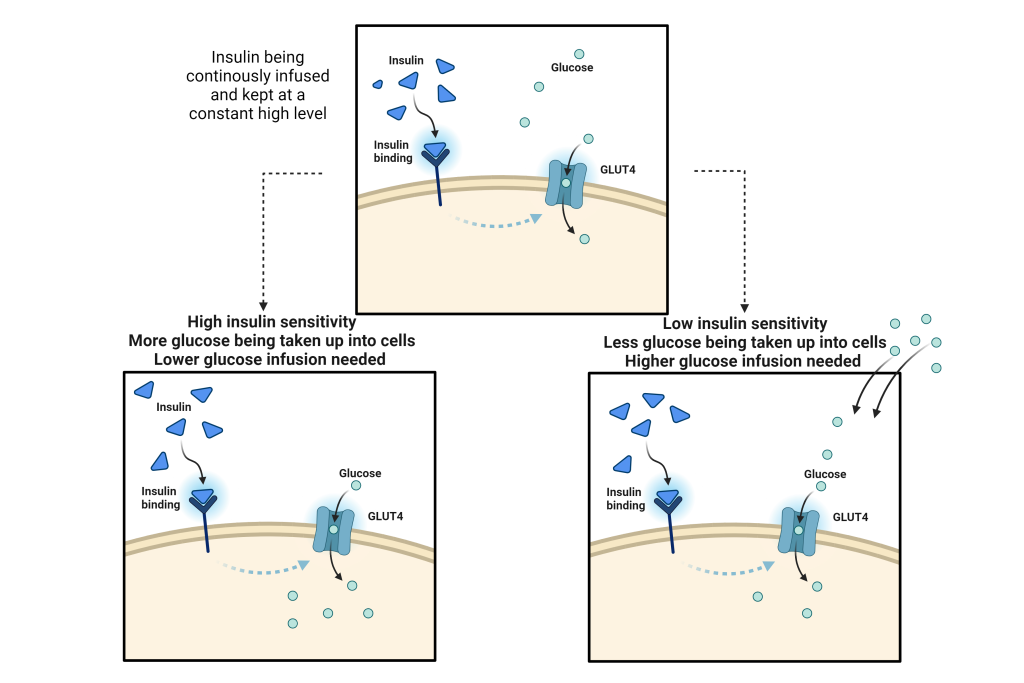Hyperinsulinemic-Euglycemic Clamp
The article, “Effect of intermittent fasting and refeeding on insulin action in healthy men” [24] delves into the impact of intermittent fasting on insulin action in healthy individuals. Here is a summary of the relevant findings and how they relate to the research topic of the effect of intermittent fasting on Type II diabetes.
In the paper, it described changes in the human genome based on the social and economic climate over time. During the Late-Paleolithic era, the human genome likely reflected the alternating periods of feast and famine that were common at this time. This contrasts with the modern sedentary lifestyle, which features constant food availability and low physical activity. This discrepancy predisposes our “thrifty” genes to incorrectly express metabolic proteins, leading to diseases like type II diabetes in industrialized regions. In simple terms, thrifty genes allow individuals to have a predisposition to store excess energy, leading to obese and overweight individuals. Thus, this study aimed to test if intermittent fasting could mimic the oscillations in energy storage seen in human ancestors, and improve insulin-stimulated glucose disposal.
A clinical trial was performed on eight healthy young men, who were instructed to follow an intermittent fasting regimen for two weeks. The subjects were analyzed before and after the 14 day study, in which fasting periods lasted for 20 hours every second day for the full two weeks. Each fast began at 10:00pm and lasted until 6:00pm the next day [24]. During the periods of fasting, only water was allowed without any caloric intake.
Before and after the full fasting period, hyperinsulinemic-euglycemic clamps were used to measure in vivo insulin action.

The hyperinsulinemic-euglycemic clamp is a technique that measures how effectively the body uses insulin to metabolize glucose. The term “clamp” refers to the method’s ability to clamp or maintain blood glucose levels at a constant, predetermined level. A continuous infusion of insulin is administered to the subject to raise and maintain plasma insulin levels at an elevated level. This ensures that any changes in glucose uptake are due to this elevated insulin level and not fluctuations in the body’s own insulin secretion. Simultaneously, a variable infusion of glucose is administered. The rate of glucose infusion is adjusted based on frequent measurements of blood glucose levels to maintain euglycemia, which means maintaining blood glucose at a normal level. The rate at which glucose needs to be infused to maintain euglycemia provides a direct measure of the body’s insulin sensitivity [25].

The procedure involves a complex interplay of molecular and physiological processes listed in order below:
- Insulin Infusion: the procedure begins with the infusion of insulin by binding to insulin receptors on the surfaces of cells.
- Activation of Insulin Receptors: when insulin binds to its receptor, it triggers a cascade of intracellular signaling pathways.
- Glucose Uptake in Cells: after insulin triggered the signaling pathway, it induces glucose uptake into cells, particularly in muscle and adipose tissue.
- Continuous Monitoring and Adjustment: during the clamp procedure, blood glucose levels are continuously monitored. The goal is to maintain euglycemia (normal blood glucose levels) despite high insulin levels. This is achieved by infusing glucose at a rate that matches the body’s increased rate of glucose utilization under the influence of insulin.
- Assessment of Insulin Sensitivity: the rate at which glucose needs to be infused to maintain euglycemia reflects the body’s sensitivity to insulin. A lower glucose infusion rate indicates higher insulin sensitivity, while a higher rate suggests insulin resistance.

The results of this study provide evidence for improved glucose metabolism by way of intermittent fasting. Although participants maintained their body weight and percent body fat throughout the study, their glucose infusion rates greatly increased throughout the period of alternating fasting. This suggests improved insulin sensitivity, as intermittent fasting increased the rate of insulin-mediated glucose uptake .
The findings from this study provide a foundation for understanding how intermittent fasting can potentially counteract certain metabolic diseases, including type II diabetes. This regimen offers a promising avenue for exploring alternative treatments for type II diabetic patients with high insulin resistance.
December 4, 2023 at 6:02 pm
The information here is all presented very well. I noticed a small typo with the word “study” in the second to last paragraph, and the extra space at the very end of the same paragraph. I feel that the conclusion two paragraphs could both use just a little bit more information relating the promising study results for intermittent fasting to the rest of the website. I am also a little confused here on how the trials were laid out. Looking at the linked article, I personally feel that this information regarding experimental study details are very important and give more context to the rest of this page: “The subjects were examined on two occasions: before and after 14 days of fasting every second day for 20 h, giving seven fasting periods. Each fasting period started at 2200 and ended at 1800 the following day (for protocol see Fig. 1). During the fasting periods the subjects were allowed to drink water and were instructed to maintain habitual activities.” beyond simply “A clinical trial was performed on eight healthy young men, who fasted for 20 hours every other day for 15 days.” Going deeper into the experimental methods used would provide more clarity and context overall. Fascinating article!
December 14, 2023 at 5:59 pm
Hey Ryan! I agree with your point on adding more information into the experimental methods of the study – and I appreciate your effort in looking into the paper to find out more. I added more details on the 14 day study with the respective fasting/feeding times. I hope this makes it more clear!
December 5, 2023 at 2:16 am
This page provided a thorough exploration of the current approaches to studying the effects of intermittent fasting on treating Type II diabetes. I appreciate the incorporation of anthropological insights into the roots of this disorder, highlighting how our contemporary lifestyles contribute to the prevalence of Type II diabetes. Drawing a connection between the occurrence of this condition in industrialized regions and the Background page’s discussion on Diabetes Mellitus among Americans was particularly insightful. The central idea of the study was also made clear through the use of a well-designed flowchart and a breakdown of the various molecular and physiological processes involved. Great job!
December 5, 2023 at 8:26 pm
This was super insightful to read, especially when considering the historical implications on our own genetics which I wouldn’t have considered otherwise! I additionally liked your flowchart describing the hyperinsulinemic-euglycemic clamp procedure. It provides a more active approach to its function, which helps a lot in my understanding as to why this specific procedure was utilized in the scientists’ methodologies. You mention in the last paragraph that this regimen can potentially “counteract certain metabolic diseases, including type II diabetes.” What other diseases can this potentially alleviate? Perhaps you could talk about further potential therapeutic use cases beyond simply diabetes.
December 8, 2023 at 6:34 pm
I really liked the evolutionary perspective taken in the second paragraph to explain the effectiveness of intermittent fasting. Great description of the hyperinsulinemic-euglycemic clamp, and Figure 3 was very informative. There seems to be a typo where “stud” was typed instead of “study.” The study discussed seems very relatable to the project premise, and hopefully, future work will be done relating to it and type II diabetes. Really nice page.
December 14, 2023 at 6:00 pm
Typo of “study” is fixed, thank you!
December 10, 2023 at 5:22 pm
The information on current methods was well presented. It is clear how intermittent fasting increases the rate of glucose uptake. While this is done in the final two paragraphs, I think this page would benefit from more description on why the findings of the study are promising for individuals with type II diabetes.